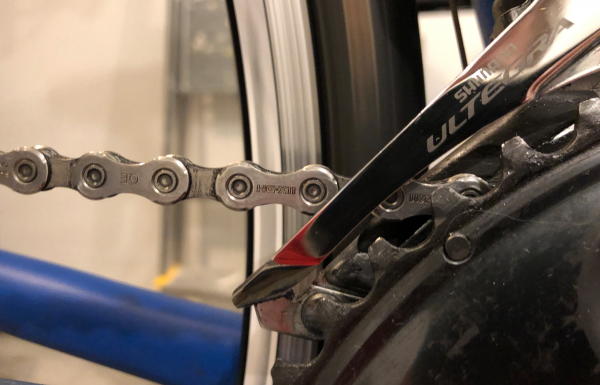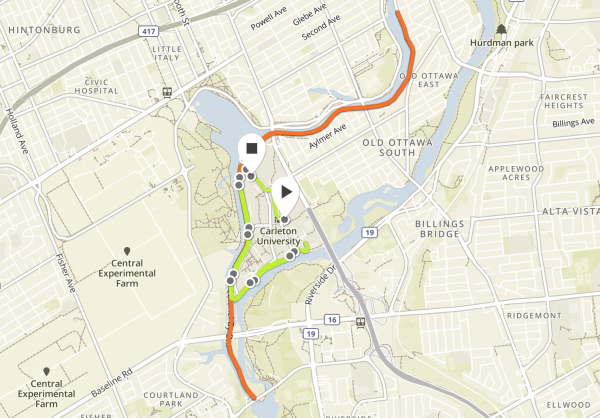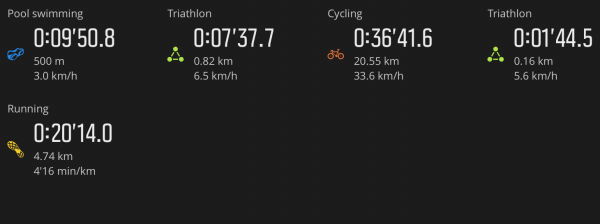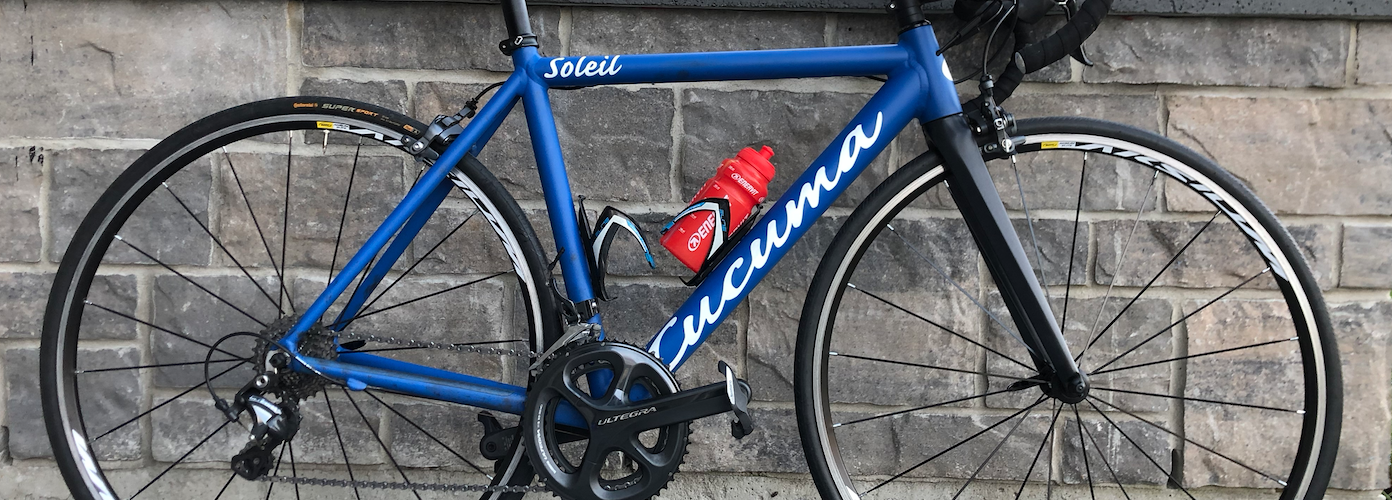Even though I’ve been training quite consistently for months and years, I don’t tend to participate in too many competitions. My last triathlon event took place almost a year ago (see here: Ironman 70.3 Kraichgau). So, it was about time to regain some routine and to do the disciplines not only individually but also all within one day.
The format: multiple competitions
The so-called Early Bird Triathlon is an established event here in the region and is usually regarded as the start of the season. Swimming takes place in a 50m pool on the university grounds (Carlton University), the bike course is closed to traffic during the competition. Multiple competitions take place simultaneously: a Try-a-Tri (100m/11km/2km), a Super Sprint (100m/11km/5km), a Sprint (500m/22km/5km) and a longer version of the Sprint (500m/33km/5km). Other formats such as Duathlon (run/bike/run) and Swim&Cycle events are also available. I decided for the Sprint-Triathlon – next week I will participate in Ottawa Marathon and I didn’t want to exhaust myself too much, but at the same time I’d be able to assess my swimming performance under race conditions and practice the transitions between the disciplines.
Preparation and strategy
The day before the event a race briefing was offered – during which strong winds, cloudy skies and temperatures around 8 degrees made clear: not necessarily the best conditions! About 100 participants listened to the briefing, far less than who had registered. We were introduced in much detail to the specifics of the venue – for example, you had to walk 700 meters from the indoor swimming pool to transition zone 1 and basically set up an additional transition zone right outside the pool.

Back home I then carefully went through all the steps several times, packed my things, finally cleaned my bicycle chain thoroughly, considered whether or not I needed a racing strategy; and came to the conclusion that I would simply race the competition by listening to my body.
Put on swim goggles – start your watch – SWIM – stop your watch – walk outside – take off googles – dry your feet – put on socks – put on shoes – put on sun glasses – put on sweater – attach bib to back – run to T1 – put on helmet – drink – switch shoes – put on gloves – walk bike out of T1 – start your watch – start bike computer – BIKE – stop your watch – stop bike computer – walk back to bike rack – take off gloves – take off helmet – take off sweater – put on cap – switch shoes – exit T2 – start your watch – RUN – stop your watch.
—My mantra during preparation…
Race day
From my home to the venue it was about 9 kilometers; close enough to directly go by bike (I don’t have a car anyway). The Sprint Triathlon was supposed to start around 8:30 in the morning. After a light breakfast (toast with cheese, coffee, water) I left the house at 6:45 am.
Many athletes already arrived and the preparation routine began: Write your starting number with black markers on your arms, park the bike in the transition zone, place helmet and gloves safely on your bike, cycling shoes next to it, as well as a water bottle. Checking the gears again, the air pressure, the brakes. Very important: Walk down the transition zone quietly and remember where you parked your bike! Afterwards we went to the indoor swimming pool – all athletes had to place sturdy shoes in front of its exit in order to be able to master the 700m to the transition zone without injury.
There was enough time for a banana and some water. Outside it was still quite chilly, about 7 degrees celsius, but at least no wind and no rain in sight. However, in the pool area it was much warmer. Everyone was asked to line up according to their estimated swimming time. All athletes swam 10x50m, one after the other, and it was in their own interest to assess their own swimming abilities well. I lined up at the 9:45-10:00min sign, not being the fastest swimmer myself.

Off we go: 500 meters swimming
It felt like eternity until I was finally in the water. There were about 150 athletes in front of me, and only every 12 seconds one was allowed to start swimming. Around 9:00am it was my turn. Off into the water, head first. I had never tried that with swimming goggles before; fortunately, they stayed tight.
The first 50m I tried to find a good rhythm without pushing too hard. The second 50m went by quite smoothly, so I pushed a bit harder. After a total of 200 meters I got closer to the swimmer in front of me and while turning I noticed that it was going to get jammed soon – one of the athletes ahead most likely had overestimated himself a bit. At 300 meters he had realized and let four or five swimmers pass, including myself. By now I was pretty much out of breath, but the remaining 200 meters I just kept on crawling steadily. Finally, it was done; and as it turned out later, I actually needed 9:50min for the 500m.
Transition One
After the pool all athletes directly left the warm building – wearing a soaked tri-suit into the open air at 9 degrees celsius. Disgusting! Quickly I put on my cycling, dried off my feet, put on socks and running shoes and sunglasses, stowed everything else in a bag. Now, 700 meters jogging to the actual transition zone, where my bike was waiting. There I had to change my shoes, put on my helmet and gloves, refuelled a bit, and off I went onto the 22 kilometers bike course. The transition time of 9 minutes sounds ridiculous, though
Staying concentrated: 22 kilometers on bad asphalt
I had already got to know the asphalt in Ottawa two weeks ago, when I had gotten off my bike straight over the handlebars due to a deep pothole; and only my helmet had protected me from anything worse than a couple of scratches.
The bike course itself wasn’t that bad, though, but it took a lot of concentration to avoid all the bumps. I kept changing my aero position in order to be able to react faster and brake better.
The first kilometers were quite long. I had no idea how much Watts I was pedalling at, but it felt a lot. After the first turning point it got better and I slowly found a good pace. I passed cyclist after cyclist and gradually worked my way up from 48th place after the swim to 32nd place at the end of the bike section. I drank about half a litre on the 22km course and arrived back in transition zone being totally out of breath.

The final stretch: 5 kilometers up and down
Changing from cycling to running was quick. Parked the bicycle, took off my helmet and gloves, switched shoes and immediately entered the running course. No idea how fast I was, I just tried to find a speed I could sustain for the next 25 minutes. The first 1.5 kilometers were uphill. Somehow it felt very slow, but while putting in a high effort. Quite unsatisfactory; and I checked my watch every 250 meters. After around eight minutes the course went downhill all the way to the turning point, then again 2.5 kilometers back. My effort increased, but the way back I felt still better. I found a good pace and was able to catch up nine more places.

After 1:15:56 my job was done – my first triathlon of the season ended, in a respectable time, and only 17 seconds past the podium of my age group.
The Early Bird Triathlon turned out to be a very well organized event. Many participants due to all the different competition formats, and all on the same track. The indoor pool start is ideal, the course is flat overall. Unfortunately, the asphalt wasn’t very good this year and the running track wasn’t really perfect either – half the way along the bike track was a little uneven on grass. But still an event to recommend; and it will most likely be my season opener for next year as well!

More to read:

